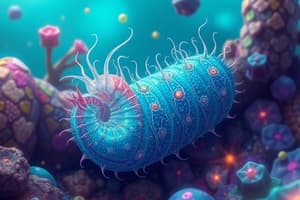Podcast
Questions and Answers
Quel groupe d'organismes est caractérisé par une segmentation spirale de leurs cellules-œufs ?
Quel groupe d'organismes est caractérisé par une segmentation spirale de leurs cellules-œufs ?
- Spiraliens (correct)
- Ecdysozoaires
- Protostomiens
- Deuterostomiens
Les plathelminthes sont des animaux bilatériens.
Les plathelminthes sont des animaux bilatériens.
True (A)
Quel est l'un des caractères complexes des plathelminthes ?
Quel est l'un des caractères complexes des plathelminthes ?
Hermaphrodisme
Les plathelminthes ont un appareil digestif complet avec une bouche et un anus.
Les plathelminthes ont un appareil digestif complet avec une bouche et un anus.
Le ______ est un groupe de plathelminthes qui comprend les planaires marines.
Le ______ est un groupe de plathelminthes qui comprend les planaires marines.
Quels sont les trois groupes de Néodermates ?
Quels sont les trois groupes de Néodermates ?
Quels sont les groupes d'Annélides qui possèdent un clitellum?
Quels sont les groupes d'Annélides qui possèdent un clitellum?
Les oligochètes sont des Annélides aquatiques qui vivent dans les eaux douces.
Les oligochètes sont des Annélides aquatiques qui vivent dans les eaux douces.
Quel groupe d'Annélides comprend les vers de terre?
Quel groupe d'Annélides comprend les vers de terre?
Quelle est la caractéristique distinctive des Achètes?
Quelle est la caractéristique distinctive des Achètes?
Les Mollusques sont principalement marins, mais ont colonisé quels autres milieux?
Les Mollusques sont principalement marins, mais ont colonisé quels autres milieux?
La coquille des Mollusques est généralement formée par le pied.
La coquille des Mollusques est généralement formée par le pied.
La ______ est une structure présente chez la plupart des Mollusques qui permet de râper leur nourriture.
La ______ est une structure présente chez la plupart des Mollusques qui permet de râper leur nourriture.
Associez les groupes de Mollusques à leurs caractéristiques.
Associez les groupes de Mollusques à leurs caractéristiques.
Flashcards
Spiraliens
Spiraliens
Groupe de protostomiens caractérisé par une segmentation spirale de leurs cellules-œufs.
Plathelminthes
Plathelminthes
Vers plats, acoelomates, souvent parasites avec un développement complexe.
Annelides
Annelides
Vers métamérisés, coelomates, avec un corps segmenté en parties identifiables.
Mollusques
Mollusques
Signup and view all the flashcards
Protozoaires
Protozoaires
Signup and view all the flashcards
Néodermates
Néodermates
Signup and view all the flashcards
Triclades
Triclades
Signup and view all the flashcards
Polyclades
Polyclades
Signup and view all the flashcards
Cestodes
Cestodes
Signup and view all the flashcards
Trematodes
Trematodes
Signup and view all the flashcards
Monogènes
Monogènes
Signup and view all the flashcards
Céphalopodes
Céphalopodes
Signup and view all the flashcards
Bivalves
Bivalves
Signup and view all the flashcards
Gastéropodes
Gastéropodes
Signup and view all the flashcards
Vermiculaires
Vermiculaires
Signup and view all the flashcards
Errants (Aciculata)
Errants (Aciculata)
Signup and view all the flashcards
Sédentaires
Sédentaires
Signup and view all the flashcards
Clitellates
Clitellates
Signup and view all the flashcards
Errants polychètes
Errants polychètes
Signup and view all the flashcards
Tubifex
Tubifex
Signup and view all the flashcards
Chitons
Chitons
Signup and view all the flashcards
Cavamolite
Cavamolite
Signup and view all the flashcards
Scaphopodes
Scaphopodes
Signup and view all the flashcards
Solénogastres
Solénogastres
Signup and view all the flashcards
Polyplacophores
Polyplacophores
Signup and view all the flashcards
Achètes
Achètes
Signup and view all the flashcards
Euthyneura
Euthyneura
Signup and view all the flashcards
Study Notes
SPIRALIENS
- A large group of bilaterian animals, encompassing Plathelminthes, Annelids, and Molluscs.
- Characterized by spiral cleavage during embryonic development.
- Demonstrate a shared evolutionary history.
PLATHELMINTHES
- General Characteristics: Flattened, unsegmented bodies; lack a coelom; a simple digestive system (often without an anus); acoelomate.
- Body Morphology: Dorso-ventrally flattened; lacking body segmentation; variable size, ranging from millimeters to a few centimeters.
- Habitat: Free-living forms inhabit marine, freshwater, and damp terrestrial environments. Parasitic forms live in a variety of hosts. Majority of species are parasitic (85%), living inside one or more hosts.
- Simple Characteristics: Lack a circulatory and respiratory systems, with a simple digestive cavity and a high surface area to volume ratio, which facilitates nutrient uptake and gas exchange.
- Complex Characteristics: Hermaphroditic (most species); complex reproductive systems; and adaptations to parasitic lifestyles (e.g., reducing sensory organs, complex holdfasts, and manipulation of the host's immune system).
- Regeneration: Remarkable regenerative abilities, particularly in planarians.
ANNELIDS
- General Characteristics: Segmented bodies; a coelom; a complete digestive system; a closed circulatory system.
- Body Morphology: Segmented bodies; most annelids are elongated with a series of repeating segments.
- Habitat: Inhabit a diverse range of aquatic and terrestrial environments.
- Coelom: The coelom is a body cavity lined with mesoderm, facilitating internal organ development and space for the growth of internal organs.
- Circulatory system: A closed circulatory system, with blood contained within vessels, allowing for efficient circulation of nutrients and oxygen throughout the body.
- Nervous system: A well-developed central nervous system.
- Key groups: Errantia (mobile species); Sedentaria (mostly sessile species); Clitellata (a group that includes earthworms).
MOLLUSKS
- General Characteristics: Soft-bodied animals; typically with a mantle, a muscular foot, and a visceral mass; often with a shell made of calcium carbonate.
- Body Morphology: A soft body typically covered in a mantle; usually a muscular foot used for locomotion; possessing a visceral mass containing internal organs.
- Habitat: Predominantly marine habitats but also inhabit freshwater and terrestrial environments.
- Diversity: Show wide variations in form and function, with many different species occupying various ecological niches.
- Key Groups: Conchifera (e.g., bivalves); Gastropods (e.g., snails); Cephalopods (e.g., octopus).
- Evolutionary features: The evolution of a complex nervous system and sensory organs contributes to their success as a group.
Studying That Suits You
Use AI to generate personalized quizzes and flashcards to suit your learning preferences.



